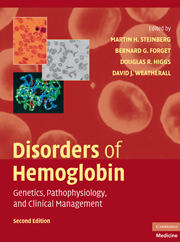Book contents
- Frontmatter
- Contents
- List of Contributors
- Foreword, by H. Franklin Bunn
- Preface
- Introduction, by David J. Weatherall
- SECTION ONE THE MOLECULAR, CELLULAR, AND GENETIC BASIS OF HEMOGLOBIN DISORDERS
- 1 A Developmental Approach to Hematopoiesis
- 2 Erythropoiesis
- 3 The Normal Structure and Regulation of Human Globin Gene Clusters
- 4 Nuclear Factors That Regulate Erythropoiesis
- 5 Molecular and Cellular Basis of Hemoglobin Switching
- 6 Structure and Function of Hemoglobin and Its Dysfunction in Sickle Cell Disease
- 7 Hemoglobins of the Embryo, Fetus, and Adult
- SECTION TWO PATHOPHYSIOLOGY OF HEMOGLOBIN AND ITS DISORDERS
- SECTION THREE α THALASSEMIA
- SECTION FOUR THE β THALASSEMIAS
- SECTION FIVE SICKLE CELL DISEASE
- SECTION SIX OTHER CLINICALLY IMPORTANT DISORDERS OF HEMOGLOBIN
- SECTION SEVEN SPECIAL TOPICS IN HEMOGLOBINOPATHIES
- SECTION EIGHT NEW APPROACHES TO THE TREATMENT OF HEMOGLOBINOPATHIES AND THALASSEMIA
- Index
- Plate section
- References
3 - The Normal Structure and Regulation of Human Globin Gene Clusters
from SECTION ONE - THE MOLECULAR, CELLULAR, AND GENETIC BASIS OF HEMOGLOBIN DISORDERS
Published online by Cambridge University Press: 03 May 2010
- Frontmatter
- Contents
- List of Contributors
- Foreword, by H. Franklin Bunn
- Preface
- Introduction, by David J. Weatherall
- SECTION ONE THE MOLECULAR, CELLULAR, AND GENETIC BASIS OF HEMOGLOBIN DISORDERS
- 1 A Developmental Approach to Hematopoiesis
- 2 Erythropoiesis
- 3 The Normal Structure and Regulation of Human Globin Gene Clusters
- 4 Nuclear Factors That Regulate Erythropoiesis
- 5 Molecular and Cellular Basis of Hemoglobin Switching
- 6 Structure and Function of Hemoglobin and Its Dysfunction in Sickle Cell Disease
- 7 Hemoglobins of the Embryo, Fetus, and Adult
- SECTION TWO PATHOPHYSIOLOGY OF HEMOGLOBIN AND ITS DISORDERS
- SECTION THREE α THALASSEMIA
- SECTION FOUR THE β THALASSEMIAS
- SECTION FIVE SICKLE CELL DISEASE
- SECTION SIX OTHER CLINICALLY IMPORTANT DISORDERS OF HEMOGLOBIN
- SECTION SEVEN SPECIAL TOPICS IN HEMOGLOBINOPATHIES
- SECTION EIGHT NEW APPROACHES TO THE TREATMENT OF HEMOGLOBINOPATHIES AND THALASSEMIA
- Index
- Plate section
- References
Summary
The genes encoding the different globin chains of hemoglobin are members of an ancient gene family. In this chapter we will review the structural features of the globin genes, with particular attention to the sequences needed for proper regulation of gene expression. Some of these have been well conserved during mammalian evolution and therefore are likely to provide a common function in many mammals. Others are only found in higher primates and may play roles in lineage-specific regulation. We will first describe the structural characteristics of the human globin genes and then provide a comparative analysis of the genomic contexts, regulatory regions, and evolutionary conservation of features present in the globin gene clusters.
NUMBER AND CHROMOSOMAL LOCALIZATION OF HUMAN GLOBIN GENES
Hemoglobin is a heterotetramer that contains two polypeptide subunits related to the α-globin gene subfamily (referred to here as α-like globins) and two polypeptide subunits related to the β-globin gene subfamily (β-like globins). Globin polypeptides bind heme, which in turn allows the hemoglobin in erythrocytes to bind oxygen reversibly and transport it from the lungs to respiring tissues. In humans, as in all vertebrate species studied, different α-like and β-like globin chains are synthesized at progressive stages of development to produce hemoglobins characteristic of primitive (embryonic) and definitive (fetal and adult) erythroid cells (Fig. 3.1).
Before precise knowledge of globin gene organization was gained by gene mapping and molecular cloning, a general picture of the number and arrangement of the human globin genes emerged from the genetic analysis of normal and abnormal hemoglobins and their pattern of inheritance.
- Type
- Chapter
- Information
- Disorders of HemoglobinGenetics, Pathophysiology, and Clinical Management, pp. 46 - 61Publisher: Cambridge University PressPrint publication year: 2009
References
- 7
- Cited by



